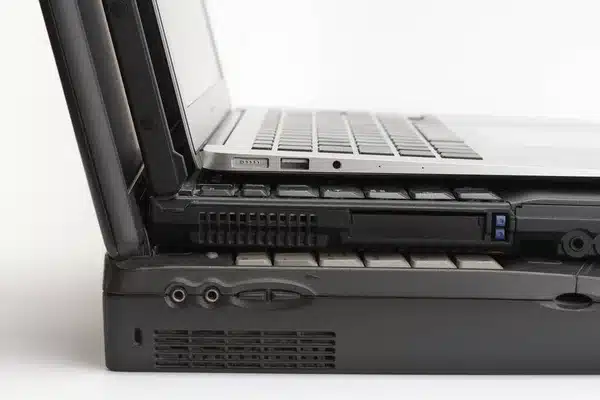Laptops have come a long way since their early days. What started as bulky, heavy machines has evolved into slim, lightweight, and powerful devices. The transformation of laptop design has been driven by advances in technology, changing user needs, and a focus on portability. Today, models like HP used laptops offer sleek designs while maintaining strong performance. For those looking for cost-effective yet modern devices, a used laptop supplier in the UK can provide high-quality refurbished options.
This blog explores how laptops have evolved over the years, from their clunky beginnings to the sleek machines we use today.
1. The Early Days: Heavy and Limited (1980s – 1990s)
The first laptops were anything but portable. They were big, heavy, and had limited functionality. Most models from the 1980s and early 1990s weighed over 5kg and had small, monochrome screens.
Key Features of Early Laptops:
- Thick Plastic or Metal Frames – Designed for durability, but very bulky.
- Small Screens – Most were 9 to 12 inches, with low-resolution displays.
- Low Processing Power – Slow processors, limited RAM, and basic storage.
- Short Battery Life – Early models lasted only 1-2 hours on a full charge.
One of the first widely recognized laptops, the IBM 5155 (1984), looked more like a portable suitcase than a modern laptop. These early models were useful for business professionals, but their lack of speed and portability made them impractical for everyday use.
2. The Shift Toward Portability (2000s – Early 2010s)
As technology advanced, laptop designs started to improve. Manufacturers focused on making devices more compact while increasing performance.
Major Design Changes in This Era:
- Lighter Materials – Aluminum and magnesium alloys replaced heavy plastic cases.
- Larger and Brighter Screens – Widescreen LCD displays (13-17 inches) became standard.
- Better Battery Life – Improved power efficiency allowed laptops to last 4-6 hours on average.
- Thinner Designs – Laptops like the HP EliteBook series became much slimmer and lighter.
During this period, HP used laptops gained popularity due to their reliable build and business-friendly features. Many of these models are still available today through a used laptop supplier in the UK, offering great value for those looking for durable and cost-effective options.
3. The Era of Ultrabooks and 2-in-1 Laptops (2013 – Present)
The last decade has seen a significant leap in laptop design. The introduction of ultrabooks and convertible (2-in-1) laptops changed the way people use these devices.
Modern Laptop Design Innovations:
- Ultra-Thin Profiles – Many laptops today are less than 15mm thick, making them easy to carry.
- Touchscreens & 2-in-1 Flexibility – Devices like the HP Spectre x360 offer both laptop and tablet modes.
- Edge-to-Edge Displays – Bezels have become thinner, maximizing screen space without increasing laptop size.
- Improved Build Quality – Stronger materials like aluminum, carbon fiber, and even ceramic are used.
- Enhanced Performance & Battery Life – Today’s models can last 10+ hours on a single charge.
Modern HP laptops, such as the HP Elite Dragonfly, combine premium materials with high-end performance. These laptops are ideal for professionals, students, and businesses looking for sleek yet powerful devices.
4. The Role of Used Laptops in Today’s Market
While brand-new laptops offer cutting-edge features, many users opt for refurbished and used models for cost savings. A used laptop supplier in the UK provides high-quality HP used laptops that still meet modern design and performance standards.
Why Used Laptops Are a Smart Choice:
- Affordability – Used and refurbished laptops cost significantly less than new ones.
- Sustainability – Buying used devices reduces electronic waste and supports eco-friendly tech use.
- Reliable Performance – Business-grade laptops, like the HP EliteBook series, are built to last and perform well even after years of use.
- Upgradable Components – Many used models allow for RAM and storage upgrades to match modern needs.
For students, freelancers, and businesses looking for a balance between price and performance, purchasing HP used laptops from a trusted supplier is a great option.
5. What’s Next? The Future of Laptop Design
Laptop technology continues to evolve, with new innovations shaping the future. Here are some trends that will likely define the next generation of laptops:
a. Even Lighter & More Flexible Designs
Future laptops may feature foldable screens or even rollable displays, making them more portable than ever.
b. AI-Powered Performance Optimization
Artificial intelligence will help optimize battery life, performance, and even security features.
c. Sustainable Materials & Manufacturing
More companies are focusing on recycled materials and energy-efficient production processes. HP, for example, has introduced laptops made from ocean-bound plastics, setting a trend for eco-friendly designs.
d. Full Cloud-Based Functionality
With the rise of cloud computing, some future laptops may remove traditional hard drives entirely, relying only on online storage and processing.
These advancements will continue to push laptop design toward even thinner, lighter, and more powerful devices.
Final Thoughts
Laptop design has evolved dramatically, from heavy, clunky machines to sleek, lightweight powerhouses. Advances in materials, battery life, and display technology have made laptops more user-friendly and efficient.
For those looking for high-quality laptops at a lower cost, a used laptop supplier in the UK offers excellent choices. HP used laptops, in particular, provide durability, performance, and modern design at a fraction of the price of new models.
As laptops continue to evolve, one thing is certain—portability, power, and style will remain key factors in future designs. Whether buying new or refurbished, today’s users have more choices than ever before, ensuring that everyone can find the perfect laptop for their needs.



